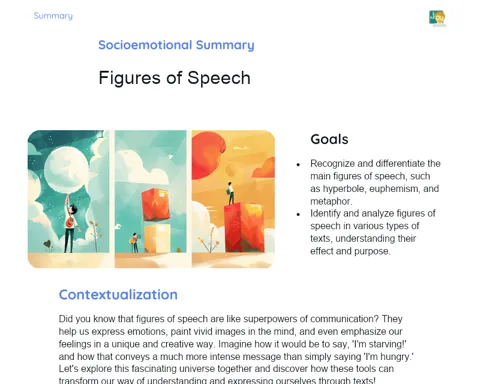Prepositions and Prepositional Phrases | Active Summary
Objectives
1. 🎯 Mastering the Use of Prepositions and Prepositional Phrases: By the end of this lesson, you will be able to accurately and appropriately apply prepositions and prepositional phrases in Spanish, significantly improving your ability to formulate sentences and express ideas clearly.
2. 🔍 Identifying Prepositions and Phrases in Texts: Learn to quickly and correctly recognize prepositions and prepositional phrases in different types of texts, which is essential for comprehension and text analysis in Spanish.
Contextualization
Did you know that prepositions are often referred to as 'the small words that govern the vast world of grammar'? In Spanish, as in many other languages, prepositions and prepositional phrases play a crucial role as they connect nouns, pronouns, and phrases to the rest of the sentence, indicating direction, location, time, and much more. Mastering their use not only improves your grammar but also expands your ability to express complex ideas clearly and effectively. Get ready to uncover the power of these 'small giants' in our learning journey today!
Important Topics
Simple Prepositions
Simple prepositions are words that, on their own, establish a relationship between two elements in a sentence. In Spanish, these small words are crucial for indicating position, time, cause, among other aspects, and include terms like 'a', 'ante', 'bajo', 'con', 'contra', and many others. Mastering their use is fundamental for constructing logically coherent and eloquent sentences.
-
Simple prepositions are used to connect words and express relationships of space, time, direction, etc.
-
Common examples include 'en' (in, at), 'por' (for, by), and 'para' (for, in order to).
-
The correct choice of preposition can significantly alter the meaning of a sentence, making it essential for accurate communication.
Prepositional Phrases
Prepositional phrases are groups of words that, together, function as a preposition. Examples in Spanish include 'a pesar de' (despite), 'debajo de' (underneath), and 'en frente de' (in front of). These expressions enrich writing and speech, providing a more elaborate and specific way to establish relationships between elements in a sentence.
-
Prepositional phrases are combinations of two or more words that express a unique prepositional idea.
-
They are particularly useful for adding clarity and detail in describing complex relationships.
-
Practical example: using 'a pesar de' instead of 'pero' to express contrast with a nuance of continuity or concession.
Practical Applications of Prepositions and Phrases
Knowing when and how to use prepositions and prepositional phrases is crucial not only in writing but also in oral communication. These structures are fundamental in instructions, descriptions of locations, expressions of time, and many other everyday situations. Additionally, the ability to correctly use these linguistic tools is an indicator of proficiency in the language.
-
Using prepositions and phrases correctly facilitates clear and effective communication in Spanish.
-
They are essential in both formal and informal contexts, from directions to academic writing or professional reports.
-
Constant practice in different contexts helps solidify the appropriate use of these grammatical structures.
Key Terms
-
Preposition: A word that establishes a dependency relationship between elements of a sentence, mainly indicating relationships of space, time, cause, among others.
-
Prepositional Phrase: A set of words that, together, functions as a preposition, enriching expression and providing specific nuances of relationship between the elements of a sentence.
-
Sentence Construction: The process of forming coherent and grammatically correct sentences, using various linguistic tools, including prepositions and prepositional phrases.
To Reflect
-
How can the choice of a preposition or prepositional phrase alter the meaning of a sentence? Give examples.
-
Why is it important to use prepositions and prepositional phrases correctly in a language that is not your native one?
-
How can practicing with maps and route descriptions help to better understand the use of prepositions and prepositional phrases?
Important Conclusions
-
Today, we uncovered the fascinating world of prepositions and prepositional phrases in Spanish. We learned that these 'small giants' are essential for forming coherent sentences and expressing relationships of space, time, and manner clearly.
-
We explored how the correct use of these elements can completely transform the meaning of a sentence, making communication more precise and effective.
-
We discussed practical examples and everyday situations where prepositions and prepositional phrases are indispensable, thus reinforcing the importance of mastering these structures to enhance both writing and speaking in Spanish.
To Exercise Knowledge
Create a fictional travel diary! For each entry in the diary, describe a day in a different city using prepositions and prepositional phrases to detail locations, routes, and experiences. This exercise will help practice the contextual use of these grammatical structures in a creative and fun way.
Challenge
Preposition Detective Challenge: Find and list at least 15 examples of prepositions and prepositional phrases in songs, movies, or series in Spanish. Analyze how these structures contribute to the messages and situations presented!
Study Tips
-
Practice with maps! Use maps of real or fictional cities and try to describe routes or locations using different prepositions and phrases. This will help visualize and embed the practical use of these structures.
-
Read aloud! Reading texts in Spanish aloud can help internalize the use of prepositions and phrases while also improving your pronunciation and fluency.
-
Use flashcards: Create study cards with a preposition or prepositional phrase on one side and its usage in a sentence on the other side. Regularly reviewing these flashcards can speed up your memorization and understanding.



